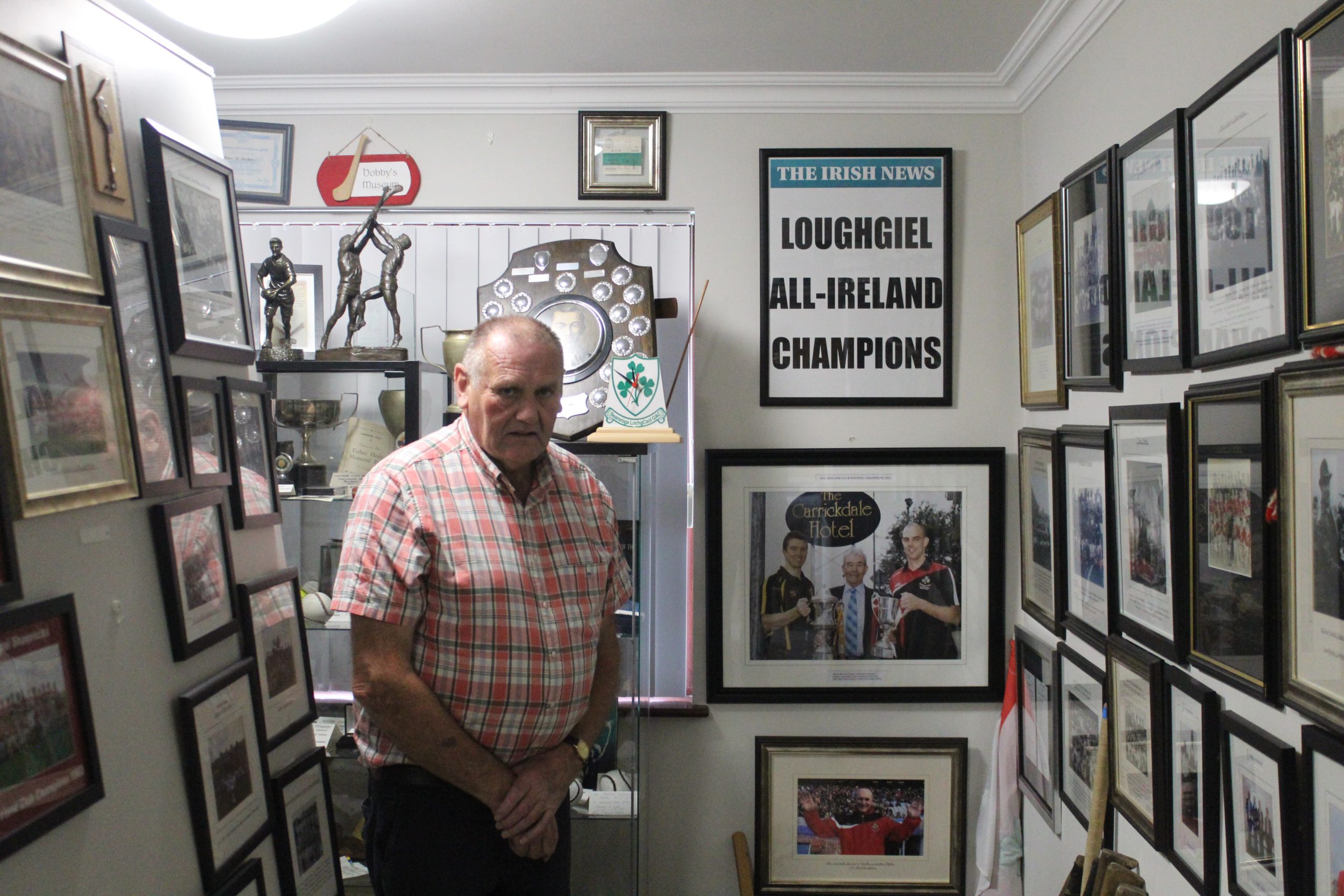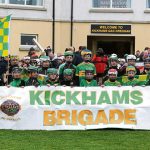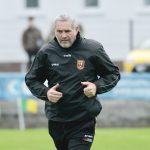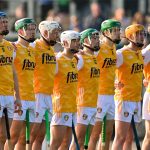Bobby McIlhatton always had an interest in history and sport. When he started collecting programmes, it grew into a museum in his Loughgiel home. Michael McMullan went to visit…
WITH every bend in the road, more and more red and white flags come into view. A sign extends the welcome to Loughgiel and a heritage of over 100 years of hurling.
The club’s senior hurlers have booked their spot in Sunday’s county final. The camogs are on the cusp of a 12th successive title.
There is a playground of excited children in the nearby Corkey Primary School. It’s breaktime. In a hotbed of the small ball, this is what it’s all about.
Bobby McIlhatton’s directions are perfect. A red and white flag flutters in the middle of the garden. The welcome is warm.
Inside, there are photos everywhere. Two jump out from the living room wall. Loughgiel’s All-Ireland winning teams of 1983 and 2012.
Above them, Liam Watson’s hurl from the 2010 Antrim final. It pinged half a dozen points from a 1-9 tally to end a hoodoo of final defeats. PJ O’Mullan’s hurl from 1983 is there too. All side-by-side with perfect symmetry.
“Hurling comes first and religion second in this parish,” McElhatton begins. From a family of 11, a love of sport is passed down from his parents. His father Patsy hurled on Loughgiel teams, winning senior medals in 1938 and ‘43.
His sister Ann was secretary of the camogie club for years. Another sister Geraldine served as a referee.
While Bobby didn’t hurl himself, he can remember late brothers Bernard and Patrick winning minor championship medals. The memories remain of the 1969 final in Glenariffe, against a Belfast amalgamation team.
“Our mother was (Nellie) Patterson from Cloughmills,” he continued, “Uncle Neil, was just Mr Loughgiel Gael. Growing up, hurling’s the only sport here in the parish.”
Neil junior, a cousin, was goalkeeper and captain of the 1983 All-Ireland winning team. One of his framed jerseys is pride of place, as you step into the museum out back.
Olcan McFetridge’s framed All-Star jersey rests beside Danny McNaughton’s number 14 Antrim jersey worn against Kilkenny in 1987.
You aren’t long in Bobby McElhatton’s house before you sink into history. His sister Clare’s art work jumps off the walls too.
“When I was growing up, going to hurling matches was just the done thing to do at the time.”
He was an impressionable teenager at the 1968 final when the Shamrocks beat Loughgiel, one of the early memories.
“The Rossa men even say it was the best final ever played in Casement Park,” he recalls. “I remember going to the Feis finals in Glenariffe when I was very young. When I was travelling to Glenariffe, you thought you were a million miles away, but it was just over the hill.”
After Sunday Mass, the McIlhatton homeplace was a hotbed of hurling chat. Loughgiel goalkeeper Johnny Coyle, grandfather of current captain Tiernan, would often be there.
The topic was turned to hurling, only varying between the last game and the one to follow later in the afternoon.
“All over the parish, hurling was the thing at the time,” McIlhatton sums up of his childhood years.
“Hurling comes first. It’s just a religion in the parish, like a whole lot of other clubs in the county. We were just brought up with it.”
Going down to the 1983 All-Ireland final, Loughgiel’s date with St Rynagh’s was a step into the dark. They had 14 of their 20 Antrim titles in the bank but this was different.
“We didn’t know what to expect going down to Croke Park,” McIlhatton recalls of the drawn game when Padraig Horan stood over a late free to win the game.
“I closed my eyes; I just couldn’t watch it. When I heard the cheer. I thought maybe it was the St Rynagh’s supporters and they won, but it was a cheer of relief.
“We went back to Casement Park a week later for the replay and I can say it’s one of the proudest days of my life. When we came back to the parish here, it was hard to believe we were All-Ireland champions.”
Too nervous to take a seat in the stand, Bobby stood on the opposite side, on the grass bank as his heroes wrote their chapter in history.
“When you’re playing a team from the south of Ireland, you really think you’re going to get one chance at them,” he added. “A lot of people thought the fact we now had them up at Belfast, we were in with a good chance. A lot of things go through your mind.”
Fast forward to 2012 and Loughgiel are Kings of Ireland again, with Liam Watson hitting three goals to sink another Offaly team, Coolderry.
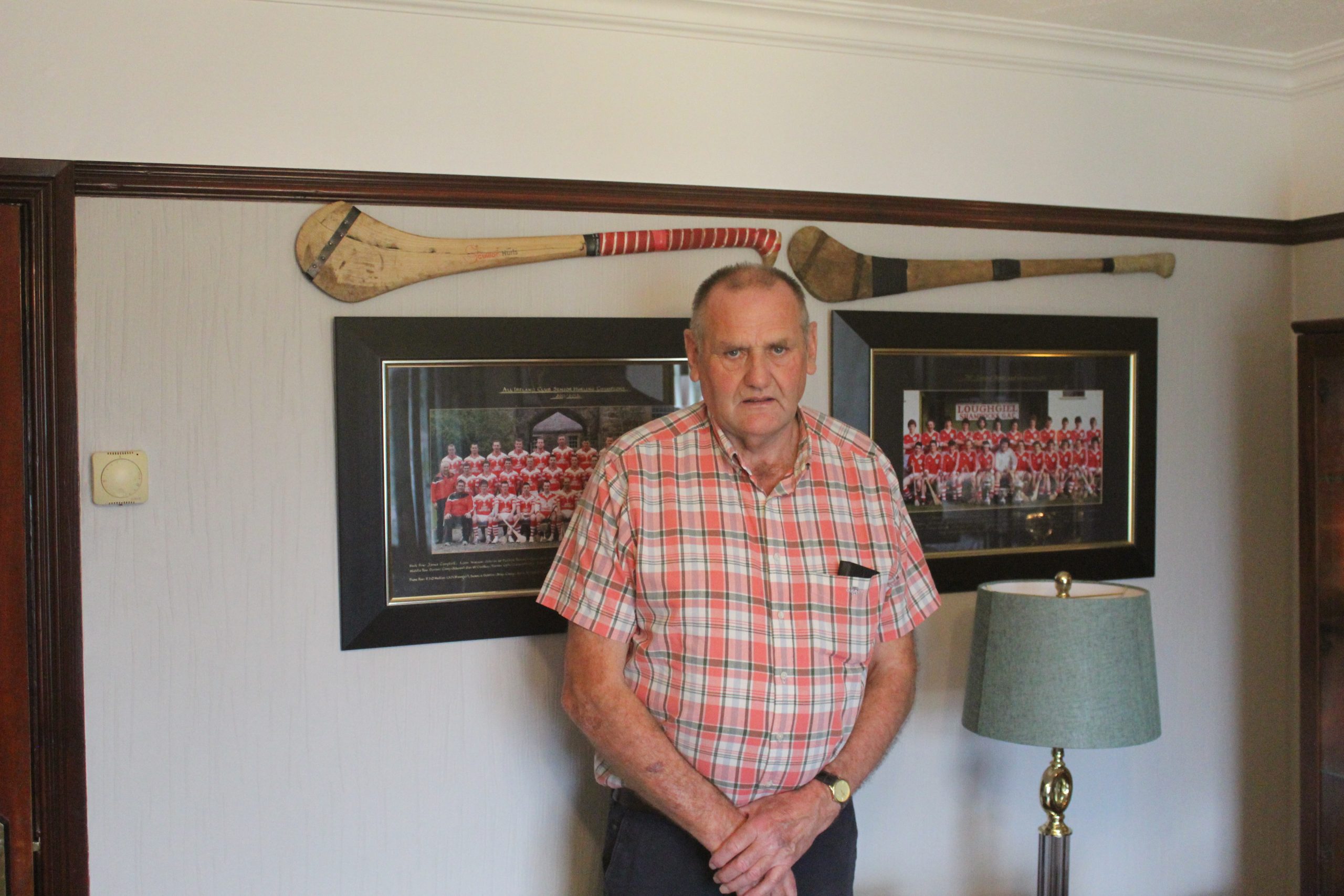
PRIDE OF PLACE…Framed All-Ireland winning teams, hurls from Liam Watson and PJ O’Mullan on Bobby McIlhatton’s living room wall
“PJ junior (O’Mullan) was in as manager, bringing in Jim Nelson and Joe McGurk with him,” McIlhatton said.
“I think Jim Nelson was a God up here. He was a real gentleman; he could talk to anybody and would never go past you.”
There are memories of Martin Scullion’s All-Ireland song and the voice of the late Gilly McIlhatton.
“After the match was over, he was the first man that rang me and I had tears in my eyes,” Bobby recalls.
“Most of the people were crying their eyes out. Bringing one All-Ireland up, but taking two over the border, it was just unbelievable and something you’ll never forget.”
Having been at a handful of club All-Ireland finals before Loughgiel etched their name on the Tommy Moore Cup, Bobby had always allowed himself to dream. What if it was Loughgiel out there, darting around Croke Park.
“It’s people that was born in your parish,” he said. “They put on the jersey at the age of 10 or 12 and they’re playing together up to senior level.
“I know the county scene is big, but, if you have no club, you have no county, that’s where everything starts, with your club.
“You have to give the mentors credit too for taking out the time to coach these young players right up through.
“We were lucky, we had a group of players that just come up at that time and were just good enough to win it.
*****
For slightly over a decade, Bobby McIlhatton’s converted bedroom has become a Mecca of all things GAA.
It’s a hidden gem. Jerseys, medals, programmes, books. Signed balls and hurls. There are seats from the old Hogan and Cusack Stands.
There is a corner dedicated to the 1920 All-Ireland football final when Loughgiel hosted a reenactment of the ‘Bloody Sunday’ All-Ireland final on its 100th anniversary.
They had old cars, kits, the lot. They even had a ball dyed brown with current senior star James McNaughton playing the role of Michael Hogan.
The museum is small in stature, yet massive. There are framed jerseys and photos. There’s even one of Liam Neeson from his days with St Patrick’s, Ballymena.
On one of the walls is a small sign, Bobby’s Museum. There is even a visitor’s book.
While not advertised as such, it’s a museum in every other instance. People arrange a time, they call around to look at artifacts, shoot the breeze over a cuppa.
The football Railway Cup trophy is on loan from Ulster GAA. Nestled in it is a ball signed by Glen’s All-Ireland winning team that includes his nephew Conor Glass.
There is a number 14 St Patrick’s, Maghera jersey from the day Glass played on the 2011 McNamee Cup winning team.
“I was over that day at the final and I remember him kicking in a few goals,” McIlhatton recalls, joking how Glass didn’t even use the hurl.
McIlhatton always had an interest in Irish history and the troubles. It moved into GAA and collecting programmes.
Year after year, he’d come home from a game with a programme. Sometimes more than one.
It grew into all sorts of memorabilia until it was time to knock down a dividing bedroom wall and Bobby’s Museum was born.
“I still need more room and I am already planning a camogie room upstairs,” he added.
A day spent in McIlhatton’s company is well spent. A Gael in every sense. Talking about it, his eyes light up.
There is a short drive to Loughgiel Community Centre for lunch. After the hellos, talk turns to camogie and Sunday’s date with Dunloy.
When his phone rings, as it often does, it’s no surprise what the tone is – The Sunday Game. What else could it be?
The calls are about anything. A fact from a final. A check of who played in a particular position. A request for a programme swap. An offer of someone tidying out an attic.
“Rather than throwing things at you, they say ‘ring Bobby’ and always can find a place for it,” he said.
He is always there to settle an argument. He recalls overhearing the late Liam McGarry in debate outside mass about who played a certain Galway team of yesteryear.
Knowing to expect a call, McIlhatton fished out the programme when he got home. And, as expected, the phone rang. It was McGarry.
“He was a big Galway man,” McIlhatton said of McGarry, who took him to many games down the years.
“Joe Cooney and him were great friends,” McIlhatton said. “Joe Cooney came up and visited here.
“We loved going to matches. I used to go with Liam and he’d drive. It was always about hurling, Liam was just hurling in the brain and we had some great days out.”
Walking into the museum, there is only one item that jumps out, opposite the door. An Irish News poster with the headline – Loughgiel All-Ireland Champions.
“I can see something other people just don’t see as worth collecting,” he said.
McIlhatton and PJ O’Mullan were over in Cloughmills for a bite of grub on the day after the 2012 win over Coolderry.
“The poster was up at the front of the Patterson’s shop, so I took it down, took it with me,” he said with a smile.
Two locked glass cabinets contain an assortment of medals, tickets, trophies. There are Munster medals belonging to former Waterford goalkeeper Clinton Hennessy who now resides in Loughgiel.
Among the sliotars are the prized ones from the 1983 and 2012 All-Ireland finals. There is also a framed set of team sheets from the 1983 All-Ireland final. This place is an absolute treasure-trove.
Liam Watson bagged 3-7 in the 2012 and was the last person to have his hand on the ball. As promised, he arrived days later with the ball.
“PJ O’Mullan was full-back in 1983,” McIlhatton recalls. “The umpire handed him the ball after the match and PJ came up and gave it to me.”
There is also a system in the museum where McIlhatton has every All-Ireland hurling final programme since 1943, having recently paid €1000 for the 1944 edition, Cork v Dublin, at an auction in Kilkenny.
“That day, there were soccer programmes and rugby programmes auctioned before the GAA ones, and they were making nothing, only making a pound,” McElhatton recalls, “but the GAA programmes were a different ball game.”
The football programmes stretch back to 1968. Like the hurling finals, they are all noted in an inventory and filed away in protective pockets, in files in order of year.
“It was very scarce because it was a wet day that day,” he said of the recently purchased 1944 hurling programme. “I’ve been looking for it for four or five years now.
“It’s just a passion I have and there’s an old saying – everybody has their own way of going mad.”
Many of the programmes are acquired by swapping but the rarer ones involve putting a hand in the pocket.
Distance to an auction is never a problem. It was the same when Liam McGarry would drive him to All-Ireland finals.
More recently it was Anthony McMullan and Sean Hardy on the road to a game. Stopping for a bite along the way. Cork, Limerick or Thurles, the location didn’t matter.
There were also the days umpiring with Tommy McIntyre that took him to Croke Park, another photo on the wall.
“I love jumping in the car and I would head away to Munster Championship matches,” he said of days in the past.
He recalls Mark Foley’s display in 1990 to sink All-Ireland champions Tipperary and Michael ‘Babs’ Keating using the “donkeys don’t win derbies” term about his injury-ridden squad.
“I remember the 1984 Munster final when Seanie O’Leary came onto the field that day in a big tear on his togs in Thurles,” he added.
When attending games in Thurles, he’d stay in Holycross, in a B&B owned by John Doyle’s family with the All-Ireland legend often mingling with guests.
“When you cross the border, something just comes over me, it’s like you’re in a different world,” McIlhatton said of his travels to the big games all over Ireland.
He also became friends with the late Kevin Cashman, the heralded sports writer from Cork who has a passion for hurling. Cashman was a regular visitor to the Pound Bar and spent a week in Antrim ahead of the 1989 All-Ireland final.
“He was a smart man about hurling,” McIlhatton said, “No matter what you asked him, he was able to tell you about teams and players all over. Sadly, he died but he gave me his collection of programmes when I was down.”
McIlhatton recalls a day in Kilkenny when he was armed with his autograph book. In one housing estate, he knocked on the door of seven All-Ireland winners.
“As a man said to me, if you lift a stone on the throw it, you’re bound to hit somebody who had an All-Ireland down there, it was the same in Tipperary or Cork,” he said.
Since meeting Bobby McIlhatton last week, Loughgiel camogs have triumphed for a 12th successive time. The hurlers are aiming to take home the Volunteer Cup for the first time since 2016. In a parish where a small ball is religion, games come and go. Joy and defeat both. Bobby’s Museum is a constant. A place where enjoyment and passion meets history.
Receive quality journalism wherever you are, on any device. Keep up to date from the comfort of your own home with a digital subscription.
Any time | Any place | Anywhere




